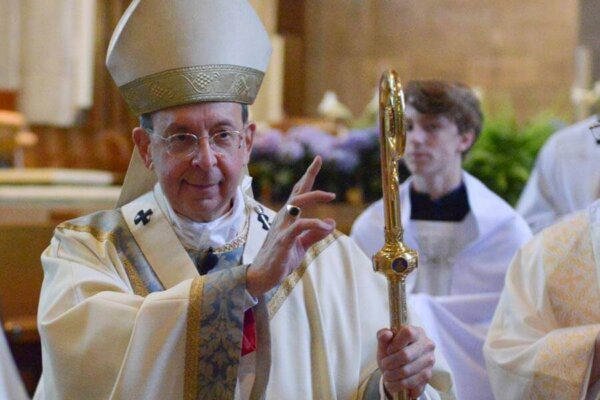5th Sunday of Lent
Holy Family, Randallstown
March 26, 2023
Our Lenten Journey
Five weeks ago, we began our Lenten observance, We pledged to participate willingly in a season of spiritual renewal through fasting, prayer, and almsgiving. Whether our Lenten journey has gone well or poorly, we now find ourselves with Jesus at Bethany, not far from Jerusalem. Finally on our way to Calvary, our pace quickens.
At length, we pause at the tomb of Lazarus. With us is the prophet Ezekiel who foretold the resurrection of the people Israel, a people whose life was all but extinguished in exile. With us too is the Apostle Paul who urges us to witness what Jesus says and does for Martha, Mary, for the crowds, and for Lazarus – not with eyes of flesh but rather with eyes enlightened by the Holy Spirit. Only such eyes can really see the signs Christ performs.
And yes, we’ve come to Bethany also accompanied by a great cloud of witnesses – the Blessed Virgin Mary, the martyrs, the doctors of the Church, the spiritual masters. With the unanimous voice of Tradition, they are pleading for us to enter upon the great events of Holy Week with a robust faith in Christ, whom we acknowledge in faith to be the Resurrection and the Life.
His Thoughts Are Not Our Thoughts
The Gospel reading tells us that, when Jesus heard that his friend Lazarus was near death, he remained where he was. With Martha and Mary and his disciples, we may wonder why Jesus did not rush to his friend’s side, there to perform a cure, to restore his health, to save him from death. So too when we face a crisis or a tragedy we ask, “Why didn’t the Lord intervene?” “Where was the Lord” we ask.
To make matters worse, Jesus does not appear in Bethany until Lazarus had been in the tomb for days. By then, Lazarus’ body had begun to decompose. His death in the flesh was complete and seemingly irreversible. Lazarus’s decomposition symbolizes the disintegration sin introduces into our lives.
Before Jesus approaches Lazarus’ tomb he approaches Martha and asks about her faith in the Resurrection. Like everyone else at the tomb, Martha believes Lazarus will rise on the last day. But Jesus has something more in mind. He wants to know: Does she believe in him? Those who live, not in the flesh but in the spirit, encounter Christ, the Resurrection and the life, who embodies the Father’s love, a love stronger than sin and more powerful than death. Encountering Jesus, we can share right now in that newness of life he won for us by dying on the cross and rising from the tomb.
St. Augustine comments that most people fear physical death, but few fear the death of the soul brought about by sin. When, at the command of Christ, Lazarus emerges from the tomb, his flesh made whole is a symbol of a deeper wholeness that comes about when our sins are forgiven . . . a wholeness of mind, heart, and spirit. The length of time Lazarus lay in the tomb speaks to the power of Christ’s love to reach even the most corrupt of sinners. Jesus’ command to untie Lazarus, to free him from his burial wrappings, symbolizes his divine power to set us free from sin. Jesus can bring us back, no matter how unlikely it may seem: “Whose sins you shall forgive, they are forgiven them; Whose sins you hold bound, they are held bound.”
The Teacher and the Stone
In today’s Gospel, Martha tells Mary, her sister, to come quickly – for Mary was at home when Jesus arrived on the scene. In truth, Martha’s words to her sister Mary are aimed at us: “The Teacher is here and he wishes to see you.”
The Lord, our Teacher and Master, is here and he does indeed wish to see us. The privileged place of this encounter, especially in these waning days of Lent, is the Sacrament of Reconciliation or Penance. In this Sacrament, Jesus meets us in a deeply personal way: He raises us up. He loosens the bondage of sin. And gives us true freedom – Not the freedom to do whatever we want, but the freedom to do what we ought – the freedom to attain that excellence by which we, like Jesus, reflect the glory of God.
Jesus asks that the stone at the entrance of Lazarus’ tomb be removed. The disciples protest and fail to understand – but we should not. Moved by Jesus’ command and the power of the Spirit let us ask to have the stone at the entrance of our heart removed. Let us not fear the decay of sin entombed within us. Rather, let us remove every barrier in our hearts, allowing the Word of Life to resound in our consciences, allowing the command of Christ to shatter our deafness, allowing the glory of Christ to revive us, restore us, bring us from sin to grace and from grace to glory.
Then and only then, will we be prepared to journey with Christ from Bethany to Jerusalem and from Jerusalem to Calvary and from Calvary to the Garden where the Author and Restorer of life and the Lover of our souls will burst forth from the tomb, he the Resurrection and the Life!
May God bless us and keep us always in his love.


